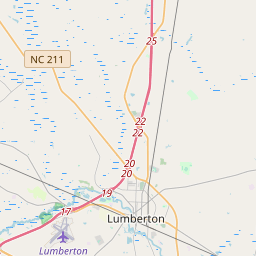Croatan Normal School
Historical marker location:
Pembroke, North Carolina
( Marker is at the intersection of State Highway 710 and West Railroad Street (Road 1515), on the left when traveling south on State Highway 710.)
Marker installed: 2013







© OpenStreetMap contributors
Loading...
Searching for other points of interest within 3 miles of this location.The state's largest city, Charlotte, was named after Queen Charlotte of Mecklenburg-Strelitz, the wife of King George III of England.
About Robeson County
Robeson County Timeline
Robeson County, located in southeastern North Carolina, has a rich and complex history that spans centuries. The area was originally inhabited by various Native American tribes, including the Lumbee, who are the largest indigenous group in the region. European exploration and settlement began in the 18th century, with Robeson County eventually being established in 1787.
During the American Revolution, Robeson County witnessed significant involvement and played a crucial role in the war effort. Many local residents joined the Patriot cause, participating in battles such as the Battle of Elizabethtown and the Battle of Hayes Pond. The county also suffered from clashes between Loyalists and Patriots, leading to a fractured society during this period.
In the 19th century, Robeson County experienced significant economic growth due to the rise of the lumber industry, which became a major source of employment and wealth in the region. The arrival of the railroad in the late 19th century further boosted economic development, leading to the establishment of towns such as Lumberton, the county seat, and Maxton.
Robeson County's history is also marked by its unique racial dynamics. Given its diverse population, the county faced challenges related to segregation and racial tension. The Lumbee people, who have a mix of Native American, African, and European ancestry, have been a dominant force in the county's culture and politics, advocating for their rights and recognition.
In summary, Robeson County's history is characterized by its involvement in the American Revolution, the growth of the lumber industry, the impact of the railroad, and the complex racial dynamics. Today, the county continues to evolve, reflecting its rich heritage while striving for progress and inclusivity.
During the American Revolution, Robeson County witnessed significant involvement and played a crucial role in the war effort. Many local residents joined the Patriot cause, participating in battles such as the Battle of Elizabethtown and the Battle of Hayes Pond. The county also suffered from clashes between Loyalists and Patriots, leading to a fractured society during this period.
In the 19th century, Robeson County experienced significant economic growth due to the rise of the lumber industry, which became a major source of employment and wealth in the region. The arrival of the railroad in the late 19th century further boosted economic development, leading to the establishment of towns such as Lumberton, the county seat, and Maxton.
Robeson County's history is also marked by its unique racial dynamics. Given its diverse population, the county faced challenges related to segregation and racial tension. The Lumbee people, who have a mix of Native American, African, and European ancestry, have been a dominant force in the county's culture and politics, advocating for their rights and recognition.
In summary, Robeson County's history is characterized by its involvement in the American Revolution, the growth of the lumber industry, the impact of the railroad, and the complex racial dynamics. Today, the county continues to evolve, reflecting its rich heritage while striving for progress and inclusivity.
Robeson County Timeline
This timeline provides a glimpse into the major events and milestones that have shaped the history of Robeson County, North Carolina.
- 1787: Robeson County was created from part of Bladen County.
- 1788: The county was officially established and named in honor of Col. Thomas Robeson, a Revolutionary War hero.
- 1791: The first courthouse was built in the county seat of Lumberton.
- 1838: The cotton industry began to flourish in the county.
- 1865: The Civil War ended, and Robeson County experienced significant economic struggles during Reconstruction.
- 1872: Railroads were introduced, improving transportation and stimulating economic growth.
- 1887: The Pembroke State Normal School (now the University of North Carolina at Pembroke) was established as the first state-supported Native American college in the United States.
- 1911: Lumbee Indians, the largest Native American tribe in North Carolina, were officially recognized by the state.
- 1914: The first paved road was completed in the county.
- 1935: The federal government established the Tuscarora Indian Reservation in Robeson County.
- 1958: The Board of Education implemented full desegregation of schools in Robeson County.
- 1997: Hurricane Floyd caused extensive flooding and devastation in the county.